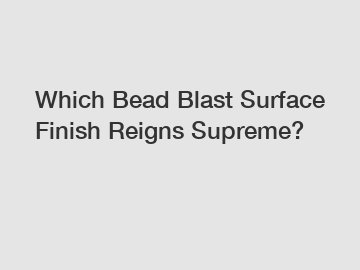Which Bead Blast Surface Finish Reigns Supreme?
Which Bead Blast Surface Finish Reigns Supreme?
When it comes to surface finishing, bead blasting is a popular technique that yields impressive results. It involves blasting small abrasive particles at high velocity onto a surface to achieve a desired texture or finish. This process is commonly used in various industries, including automotive, aerospace, and even jewelry. But with different types of bead blast surface finishes available, which one truly reigns supreme? Let's delve into the world of bead blast surface finishes to find out.
1. Glass Bead Blasting:

Glass bead blasting is one of the most common bead blast finishes. It involves using tiny glass beads as the abrasive material. This technique provides a smooth and satin-like finish, making it perfect for applications where a clean, elegant surface is desired. Glass bead blasting is often utilized in industries that require a precise and uniform appearance, such as medical devices and high-end machinery components.
2. Steel Shot Blasting:
Steel shot blasting, on the other hand, utilizes small steel balls as the abrasive medium. This process creates a textured, matte surface that is ideal for applications requiring enhanced adhesion, such as the preparation of metal surfaces for coatings or paints. Steel shot blasting is widely used in industries like automotive, where parts need to withstand harsh environments and maintain their finish over time.
3. Aluminum Oxide Blasting:
Aluminum oxide blasting involves using fine aluminum oxide particles as the abrasive agent. This technique offers a versatile range of finishes, from smooth to rough textures, depending on the desired outcome. Aluminum oxide blasting is commonly utilized in industries such as aerospace, where a controlled removal of surface material is necessary to improve adhesion or create specific geometries.
4. Crushed Glass Blasting:
Crushed glass blasting uses recycled glass particles to create a unique surface finish. This method produces an irregular and textured surface that can be adjusted depending on the size of the glass particles used. Crushed glass blasting is often employed in applications where environmental concerns and sustainability are prioritized, such as eco-friendly construction and restoration projects.
Having explored these different bead blast surface finishes, it becomes apparent that no single technique reigns supreme in all scenarios. The ideal choice depends on the specific requirements and desired outcome of the project at hand. For industries seeking a smooth and refined finish, glass bead blasting is the go-to option. Meanwhile, steel shot blasting excels when enhanced adhesion is essential. In cases where versatility and control over surface texture are vital, aluminum oxide blasting is the preferred choice. Lastly, crushed glass blasting offers a sustainable solution with its unique, eco-friendly surface finish.
In conclusion, the debate over which bead blast surface finish reigns supreme cannot be definitively answered. Each technique serves a purpose in various industries and applications, catering to specific needs and preferences. Glass bead blasting, steel shot blasting, aluminum oxide blasting, and crushed glass blasting all have their own unique strengths and advantages. The key lies in selecting the most suitable option based on the project requirements, ensuring a high-quality and visually appealing surface finish. So, next time you embark on a bead blast surface finishing project, remember to choose wisely to achieve the desired results.
Contact us to discuss your requirements of water ripple metal texture, silver or stainless steel, mirror polished stainless. Our experienced sales team can help you identify the options that best suit your needs.


